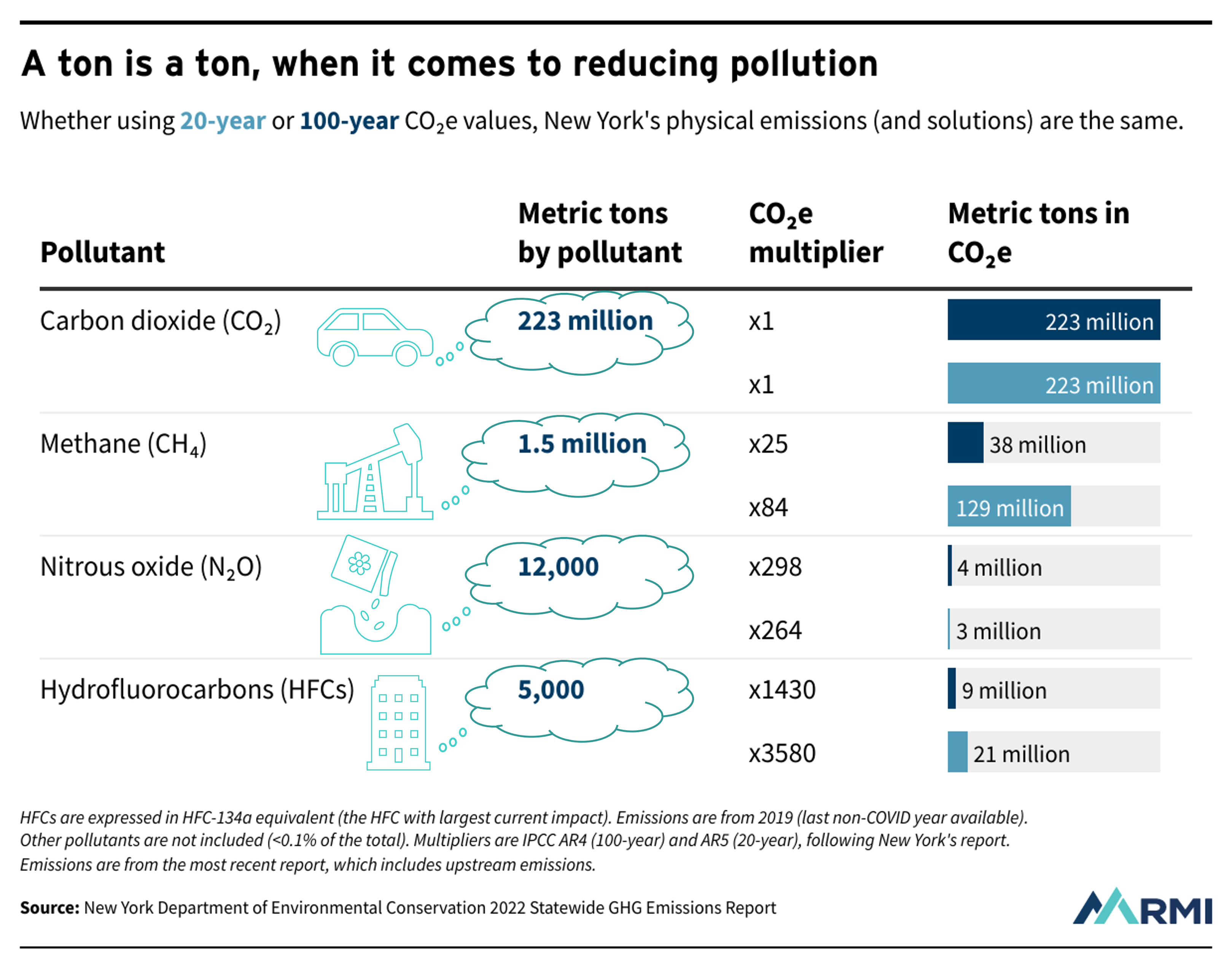
Reality Check: The Missing Pieces of New York’s “Climate Math” Debate
A wonky accounting method has sparked another “cost vs. climate” debate — but some key implications have been overlooked.
In March, we wrote about the sticky problem of climate math. In April, this very topic was a political lightning rod in New York State. At stake: a late-breaking budget proposal to overturn the new emissions accounting enshrined in the state’s climate laws.
The proposal sparked fierce opposition from many scientists, advocates, and politicians who argued that the change would weaken New York’s landmark legislation. State officials had supported the proposal to address cost concerns, before backing off for now.
Still, the debate is far from over. Here, we explore those key cost and benefit questions around New York’s emissions accounting — and the implications for effective climate action in the Empire State and beyond.
Comparing the Benefits: Why New York’s Accounting Strengthens Its Climate Targets
New York’s 2019 Climate Leadership and Community Projection Act has added three notable distinctions to its accounting. First, the inclusion of some out-of-state emissions (from imported energy and exported waste) helps New York address the upstream impacts of its fossil fuel use. Second, the counting of biogenic gross emissions (from burning plant-based fuels) helps highlight those pollution sources, despite attempts to treat them as carbon-neutral (which international experts do not fully support).
Finally, there’s the wonky question of global warming potential (GWP) — which decides the timeframe to compare the many pollutants that warm our planet. Longer timeframes prioritize long-lived CO2 and nitrous oxide, while shorter timeframes prioritize the short-lived pollutants (like methane) that have driven nearly half of human-caused climate change. This was the focus of April’s debate — and whether New York’s move to a 20-year timeframe (GWP20) should revert to 100 years (GWP100).
Yet there’s more to the story. Let’s examine three paths to meet New York’s 2050 emissions goals: one with its old climate math (based on the June 2020 decarbonization study), and two that use the new climate math, with and without upstream emissions (based on the December 2022 scoping plan).
All meet the same stated emissions target (85 percent gross reduction from 1990 to 2050), but the math makes a major difference for temperature. When compared with the latest reference case in 2050, the pathway with all-new accounting would improve the benefits (in avoided temperature rise) by 66 percent over the old accounting.
Most of the difference comes from upstream emissions, since addressing more sources has more benefits. GWP20 contributes by adding urgency for short-lived methane and hydrofluorocarbons (HFCs), since progress to date has been better for CO2. Both changes promote the shift from methane gas to clean electricity — improving climate and health benefits alike.
These benefits can be estimated monetarily, as they are in New York’s Scoping Plan. Global climate damages are a less obvious cost than utility bills — but as we saw from June’s horrifying wildfire smoke, avoiding them is crucial for the well-being of New Yorkers. Based on New York’s methods, the new accounting would avoid as much as $240 billion in damages — a benefit that the math debates have largely ignored.
Checking the Costs: Why New York’s Debate Is Incomplete
So if the climate math adds ambition, does it hurt affordability? Not necessarily. New York will have a clearer answer by next year, when state officials will release an affordability study for their central cap-and-invest policy. But the reality may be brighter than initial estimates (which blame climate math for higher costs). A key reason: the wonky GWP timeframe that ignited April’s debates.
Initial estimates assumed that New York’s 20-year GWP timeframe meant more emissions, and therefore higher costs for New Yorkers. However, this reasoning is incomplete because physical emissions do not change with accounting timeframes. With a 20-year timeframe (vs. 100 years), short-lived methane and HFCs are expressed as a larger portion of the emissions challenge (in tons of carbon dioxide equivalent, or CO2e). Still, the actual tons of each pollutant are unaffected. It’s like cutting the same pizza into six slices or eight: the latter has more slices, but not more pizza.

The math’s new priorities could affect costs if methane and HFC actions are costlier — but evidence shows that they might not be. New satellites, federal programs, and business commitments could help to cost-effectively reduce oil and gas methane leaks, while electrification of buildings and strategic decommissioning of the gas distribution system — a key strategy in the state’s decarbonization plan — would provide permanent reductions.
Finally, there are many ways to prioritize affordability (as we should). Policy design choices regarding New York’s cap-and-invest program and the proposed NY HEAT legislation can enhance affordability for consumers and small businesses. Inflation Reduction Act funding could cut climate action costs in New York by up to 19 percent. And above all, action saves money for climate and health — with at least $115 billion in net benefits if New York’s targets are met.
Addressing All Pollutants Brings Maximum Benefits
Let’s conclude by stepping back. We’ve covered the benefit and cost angles of New York’s climate math debate. But we should consider the big picture — and the need to address all emissions to avert the worst impacts of climate pollution.
Picking one accounting timeframe is a false choice — as international scientists emphasize the need for net-zero emissions of long-lived CO2 and sharp cuts of short-lived pollutants like methane. Both timeframes are crucial to protect ourselves and our children.
So what should decision makers do with their climate math? One approach: whatever can promote action for underappreciated emissions. New York’s math was one option for the situation, and there have been recent efforts in California, Washington, Massachusetts, Rhode Island, and beyond to consider 20-year timeframes (as Maryland does) and not just 100 years. Inter-state policies would need to discuss their timeframe, or track pollutants separately to avoid inconsistencies.
But there are many ways to address all pollutants — such as separate reporting, separate goals (like in California as well as many countries), and improved monitoring (to address widespread methane undercounting, for example). Such action need not hold a cost vs. climate dichotomy, either — as thoughtful policy design can build on market forces that are accelerating cost-effective solutions. No matter the math, we can affordably act on all emissions for a healthy future.